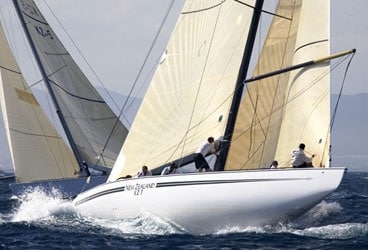
Twelves368
In a recent AC eNewsletter, I described the history of the 12-Meter Class, which began its 100th anniversary celebration with a regatta in Valencia, Spain. This international gathering begs the question, “Why do owners continue to put so much effort and expense into these dinosaurs?” The 12-Meters and other, smaller survivors of the International Rule avoid extinction because they have their own attractiveness: they bear out the value of vintage. While other classic yachts disappeared from the racing scene, 12-Meters remain thanks to their durability, “upgrade-ability,” and suitability for racing and daysailing alike.Because of its age, the 12-Meter Class has a few distinct generations, each offering its own motivations for ownership and use. The divisions were set according to two notable performance breakthroughs in the Class– the separated rudder plus trim tab of Intrepid in 1967 and the winged keel of Australia II in 1983– and allow like yachts to compete against one another when there are enough 12-Meters present.The boats’ durability can be attributed to the Class Rule, which required scantlings to comply with Lloyd’s Rules for the International Rating Classes. Through 1987, 12-Meter construction took place under the scrutiny of the survey by Lloyd’s. Thanks to these high standards of strength and construction, more than 100 of the 180 hulls built between 1907 and 1987 remain. The Class’ masts are built to strict standards, as well, with limits on section dimensions, weight, and height. 12-Meter masts are reasonably interchangeable, so a surplus of existing masts provides replacements, especially for the middle-aged boats. The second reason that the 12-Meters continue to thrive is that like boats can be tuned to sail at close to the same speed. The 12-Meters are heavy-displacement boats, and the rating rule constrains length and sail area such that the boats’ speed potential fits within a fairly narrow band. As length goes up, sail area comes down, resulting in decent parity within the three divisions of the Class.A system of age credits accounts for jumps in performance at the generational breaks and, among the Modern (Intrepid 1967-1983, excluding Australia II) and Classic (pre-Intrepid) divisions, for design obsolescence over time. Additionally, credit is given for self-propulsion with an exposed propeller. Yachts in the Grand Prix Division (Australia II and later) race to the full Class Rule with no concessions.The generational divisions and 12-Meter-specific ratings system helps guide owners into the boat that best fits their objectives and budget. The current Grand Prix division is made up of yachts from the 1987 America’s Cup. These boats were designed for the heavy air of Fremantle, Australia. To make them competitive in lighter-air venues like Newport, R.I., and the Mediterranean, owners may reconfigure the boats’ rating trade-offs of length, displacement, and sail area. Additionally, advancements in hydrodynamic design require owners of Freemantle 12-Meters to fit new appendages in order to be fully competitive. Improvements in spars, hardware, and sails demand new purchases, as well. The cost of an unimproved Grand Prix yacht is only the tip of the financial iceberg, but a fully improved GP 12-Meter still offers good value for a 14-person, 65-foot racing yacht.The advantage of buying a Modern division 12-Meter is that the boats were designed for the moderate conditions of Newport in the first place. Reconfiguring does not necessarily involve major keel work, and upgrades to rudders, rigs, winches are not essential right away.Classic division 12-Meters are an altogether different story. At times, it seems their beauty inspires irrational exuberance. They are sturdy, so they are good candidates for preservation or restoration, and the fleet is the pretty large, too. The revival of Classic division 12-Meters in Newport began 30 years ago with the late Bob Tiedemann’s Gleam, and the local Newport fleet has grown to include eight 12-Meters built between 1928 and 1964. All but the fully-restored, 1928 Onawa have been maintained continuously with occasional, significant refits. These yacths live a mixed life as daysailing charter boats and, for their owners, racers and cruisers. There are even more Classic 12-Meters active in Europe, most of which are privately owned and have undergone substantial restorations. In Valencia, Vanity V, Trivia, and Wings– all built between 1936 and 1937- are in brand-new condition. Despite being exquisite antiques, the pressed each other hard in 20-knot winds during the centennial regatta, with the winner not decided until the seventh and final race.Which brings me to the third reason for the 12-Meter revival- owners are enjoying themselves. Many owners steer or serve in other active roles, and have developed their crews to include friends, very capable amateurs, and a limited number of professionals. While the professional tilt is stronger in the Grand Prix Division and almost absent in the Classics, the priority on owners having fun isn’t lost in any of them. With the average age of 12-Meter owners and crews not much younger than the yachts that they are racing, there is good camaraderie ashore, and owners usually have a special gathering at each major regatta. Getting their yachts into pristine form gives these owners plenty of satisfaction, but the greatest enjoyment comes from competing in refined yachts that combine technical preparation and sailing skill. The centennial celebration resumes in September in Porto Cervo, Sardinia, Italy, followed by the World Championship Regatta in Cannes, France, and concluding with Les Voiles de St. Tropez in early October. For results from the Valencia regatta, click here.









